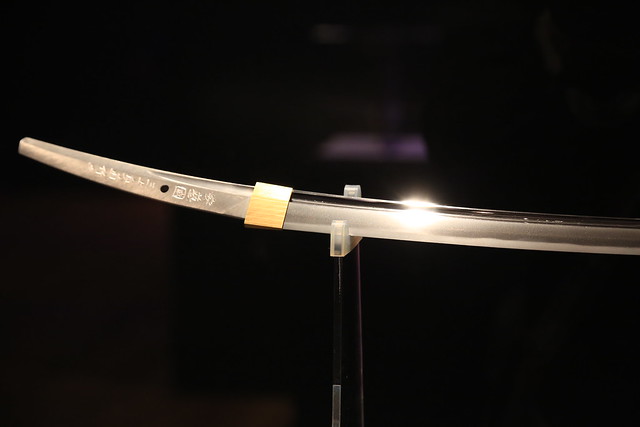This blog mainly introduces traditional Japanese things including seasonal events, flowers, confectionery, handicrafts, bunraku(Japanese puppet theater). Short introductions and links to all of my blog posts are shown on four calendar pages on sidebar.
Events:
cherry blossom forecast:
https://n-kishou.com/corp/news-contents/sakura/?lang=en
https://sakura.weathermap.jp/en.php
https://tenki.jp/sakura/
https://weathernews.jp/sakura/news/
cherry blossom forecast:
https://n-kishou.com/corp/news-contents/sakura/?lang=en
https://sakura.weathermap.jp/en.php
https://tenki.jp/sakura/
https://weathernews.jp/sakura/news/
Thursday, September 18, 2014
The 61st Japan Traditional Art Crafts Exhibition
The 61st Japan Traditional Art Crafts Exhibition(日本伝統工芸展) is being held at Mitsukoshi department store in Tokyo from September 17 to 29.
The exhibition requires the applicants to create sophisticated design based on high degree of professional skill in Japanese traditional techniques.
See the Japan Kogei Association site for further information:
http://www.nihonkogeikai.or.jp/ (Japanese version only)
The Exhibition will travel through the following venues:
Mitsukoshi Nihonbashi Main Store, Tokyo
September 17-29, 2014
Mitsukoshi Nihonbashi Main Store:
http://mitsukoshi.mistore.jp/store/nihombashi/index.html
Mitsukoshi Nagoya Sakae Store, Nagoya City, Aichi Prefecture
October 1-6, 2014
Mitsukoshi Nagoya Sakae Store:
http://mitsukoshi.mistore.jp/store/common/fcs/index.html
Takashimaya Kyoto Store, Kyoto Prefecture
October 8-13, 2014
Takashimaya Kyoto Store:
http://www.takashimaya.co.jp/
ABENO HARUKAS(11F & 24F), Osaka City, Osaka Prefecture
October 16-22, 2014
ABENO HARUKAS:
http://www.abenoharukas-300.jp/
Kintetsu Department Store Main Store Abeno Harukas(11F):
http://abenoharukas.d-kintetsu.co.jp/
Osaka University of Arts Sky Campus(24F)
Ishikawa Prefectural Museum of Art, Kanazawa City, Ishikawa Prefecure
October 31-November 9, 2014
Ishikawa Prefectural Museum of Art:
http://www.ishibi.pref.ishikawa.jp/english/index.html
the Okayama Prefectural Museum of Art, Okayama City, Okayama Prefecture
November 13-30, 2014
The Okayama Prefectural Museum of Art:
http://www.pref.okayama.jp/seikatsu/kenbi/index-e.html
Shimane Art Museum, Matsue City, Shimane Prefecture
December 3-25, 2014
Shimane Art Museum:
http://www1.pref.shimane.lg.jp/contents/sam/index.html
the Kagawa Museum, Takamatsu City, Kagawa Prefecture
January 2-18, 2015
The Kagawa Museum:
http://www.pref.kagawa.lg.jp/kmuseum/foreign/
Mitsukoshi Sendai Store, Sendai City, Miyagi Prefecure
January 22-27, 2015
Mitsukoshi Sendai Store:
http://mitsukoshi.mistore.jp/store/sendai/index.html (Japanese version only)
Mitsukoshi Fukuoka Store, Fukuoka City, Fukuoka Prefecture
February 3-8, 2014
Mitsukoshi Fukuoka Store:
http://www.m.iwataya-mitsukoshi.co.jp/index.html
Mitsukoshi Matsuyama Store, Matsuyama City, Ehime Prefecture
February 17-22, 2015
Mitsukoshi Matsuyama Store:
http://mitsukoshi.mistore.jp/store/matsuyama/index.html (Japanese version only)
Hiroshima Prefectural Art Museum, Hiroshima City, Hiroshima Prefecture
February 25-March 15, 2015
Hiroshima Prefectural Art Museum:
http://www.hpam.jp/
Friday, August 1, 2014
morning glory exhibitions
Morning glory has been a representative flower of summer in Japan. Many people were interested in gardening or growing flowers and plants in the Edo period. The plant attracted everyone from feudal lords to common people. Two morning glory booms took place in the 19th century. A lot of cultivated varieties of morning glories had been developed during the Edo Period.
The lords of the Higo Domain encouraged the cultivation of flowers including Chinese Peony, chrysanthemum, Japanese camellia, Morning Glory, Hanashobu(Iris ensata var. ensata) and Christmas Camellia as a mental training for samurai.
Several morning glory exhibitions are being held now. However, visitors can see the flowers only during morning.
The lords of the Higo Domain encouraged the cultivation of flowers including Chinese Peony, chrysanthemum, Japanese camellia, Morning Glory, Hanashobu(Iris ensata var. ensata) and Christmas Camellia as a mental training for samurai.
Several morning glory exhibitions are being held now. However, visitors can see the flowers only during morning.
About 500 large-flowered morning glories are being displayed in Mukojima- Hyakkaen Gardens(向島百花園), Sumida Ward, Tokyo from July 27 to August 3, beginning at 8 AM.
Mutant morning glories developed in the Edo Period and large-flowered ones are being displayed in Hibiya park, Tokyo from July 28 to August 3. No admission fee is required. Henka Asagao Kenkyukai(変化朝顔研究会, society for the studies of mutant Japanese morning glories) and Society for The Japanese morning glory studies in Tokyo(東京朝顔研究会) play host to the event. The mutants will also be displayed from August 29 to 31 in the park.
Henka Asagao Kenkyukai (Japanese version only):
The Japanese morning glory studies in Tokyo (Japanese version only):
The 55th Morning Glory Exhibition in the Kyoto Prefectural Botanical Garden will be held from August 1 to 5.
Three hundred mutant morning glories of 56 different types were displayed at Sengan-en Garden(仙巌園) in Kagoshima Prefecture from July 12 to 27.
Nagoya Morning Glory Festival in Nagoya City was held from July 23 to 27.
Saturday, July 19, 2014
Gion Festival in 2014
Sorry for the late update. It's been a long time.
Summer vacation has started for most students. In Japan, a lot of fireworks and festivals take place in summer. Some bon dance festivals were held in my area this weekend and also last weekend.
fireworks & summer festivals(Japanese version only):
http://hanabi.yahoo.co.jp/
http://www.rurubu.com/season/summer/hanabi/
The Gion Festival(祇園祭) is being held in Kyoto from July 1 to the 31.
about Gion Festival:
http://ichinen-fourseasonsinjapan.blogspot.jp/2010/07/end-of-rainy-season-and-gion-festival.html
http://ichinen-fourseasonsinjapan.blogspot.jp/2011/07/gion-festival1.html
http://ichinen-fourseasonsinjapan.blogspot.jp/2011/07/gion-festival2.html
The festival's highlight is a parade of 33 beautifully decorated floats named Yamaboko-junko or Yamahoko-junko(山鉾巡行).
The parade takes place to ease crowding on July 17 and 24 this year. All of the floats had paraded in a day since 1966. Twenty-three floats paraded on the 17th, and 10 will do on the 24th.
The Ofune-boko(大舩鉾) float will return to the parade on the 24th after an almost 150-year absence this year. The float was burned by the Onin War in 1467, a big fire in 1788, and the rebellion at the Hamaguri Gate (蛤御門の変) in 1864. Other yamahoko floats were also damaged by fires and wars to some degree. Taka-yama(鷹山)and Hotei-yama(布袋山) floats can't return to the parade.
The floats are lit up with paper lanterns in the evening.
(23 floats on 14-16, 10 floats on 21-23)
Summer vacation has started for most students. In Japan, a lot of fireworks and festivals take place in summer. Some bon dance festivals were held in my area this weekend and also last weekend.
fireworks & summer festivals(Japanese version only):
http://hanabi.yahoo.co.jp/
http://www.rurubu.com/season/summer/hanabi/
The Gion Festival(祇園祭) is being held in Kyoto from July 1 to the 31.
about Gion Festival:
http://ichinen-fourseasonsinjapan.blogspot.jp/2010/07/end-of-rainy-season-and-gion-festival.html
http://ichinen-fourseasonsinjapan.blogspot.jp/2011/07/gion-festival1.html
http://ichinen-fourseasonsinjapan.blogspot.jp/2011/07/gion-festival2.html
 |
| Yamaboko-junkophoto by 京都フリー写真素材 |
The festival's highlight is a parade of 33 beautifully decorated floats named Yamaboko-junko or Yamahoko-junko(山鉾巡行).
 |
| Yamaboko-junko, Fune-hoko(船鉾)photo by 京都フリー写真素材 |
 |
| It is crowded again this year! |
The parade takes place to ease crowding on July 17 and 24 this year. All of the floats had paraded in a day since 1966. Twenty-three floats paraded on the 17th, and 10 will do on the 24th.
 |
| Ofune-boko photo by 全33頁 祇園祭山鉾巡行写真集 |
The Ofune-boko(大舩鉾) float will return to the parade on the 24th after an almost 150-year absence this year. The float was burned by the Onin War in 1467, a big fire in 1788, and the rebellion at the Hamaguri Gate (蛤御門の変) in 1864. Other yamahoko floats were also damaged by fires and wars to some degree. Taka-yama(鷹山)and Hotei-yama(布袋山) floats can't return to the parade.
 |
| photo by 京都フリー写真素材 |
(23 floats on 14-16, 10 floats on 21-23)
Saturday, March 15, 2014
Three years
Three years have passed since the Great East Japan Earthquake on March 11. The government-sponsored memorial ceremony for its victims was held on March 11 and its participants observed a silent prayer at 2:46 p.m., the exact time the earthquake occurred.
As of March 10, 15,884 people died, 2,633 are missing, and 2,973 died from overwork, illness or suicide after the quake. As of February 13, 267,419 people are living in temporary or public housing, rented accommodation, relative's homes. Many families of victims are still waiting for their missing family members.The search for missing persons is still continuing.
In Miyagi and Iwate prefectures, most debris was disposed of, but most of their tsunami-hit areas are still vacant. The shortage of materials and human resources constitutes barriers to getting public-works projects under way. The population of the areas has decreased. Many of the areas need to review reconstruction projects. Many people concern that the 2020 Tokyo Olympics would take away materials and human resources from the areas.
There has been so much debris in Fukushima Prefecture. Time has stood still for several towns next to Fukushima Daiichi nuclear power plant since that terrible day. The Japanese government has lifted ban on entry or return to some parts of the exclusion zone, but most of young ex-residents are not going to return their home town.
Decommissioning of the nuclear plant is expected to take at least 40 years to complete. Contaminated water in the plant sometimes makes the news. The decontamination operations have made little progress. We feel overwhelmed by this harsh conditions.
Some of the victims want to forget, some don't want to forget, but they all can't forget the terrible day.
Sochi gold medalist Yuzuru Hanyu was on a skating rink in Sendai, Miyagi Prefecture when a giant earthquake occurred on 11 March 2011 at 14:46 JST. He got away from the building with skating shoes on. The rink looked like the rolling sea.
The then-16-year-old figure skater lost his home and his home rink due to the quake(not tsunami - BBC wrote a mistake), spent four nights with his family on the evacuation center's floor, being frightened by intermittent aftershocks, shivering from the cold in the dark.
The earthquake caused failures in all types of lifelines including electricity, gas, water and telecommunication systems.
He performed in about 60 ice shows and practiced on the skating links where the shows were held. His home skating rink was restored four months after the quake. Though his condominium was identified as fully-destroyed, his family stays living there after the extensive repair work.
He said: Shortly after the quake, I was obsessed with survival. I wondered if I should go on skating. There were times when I thought of quitting skating. As an Olympic gold medalist, I think that I could be of assistance to the disaster victims. This is just the start.
He felt guilty about leaving Sendai for Toronto, Canada to achieve a high goal in May 2012.
He received 6,000,000 yen from the Japanese Olympic Committee and the Japan Skating Federation. He said he would donate his full reward to the devastated areas.
He observed two minutes of silence toward Japan on March 11 at 1:46 Toronto Time(14:46 Japan time) this year. As an aside, he has asthma. He takes medicine every day, and never go anywhere without his inhaler.
As of March 10, 15,884 people died, 2,633 are missing, and 2,973 died from overwork, illness or suicide after the quake. As of February 13, 267,419 people are living in temporary or public housing, rented accommodation, relative's homes. Many families of victims are still waiting for their missing family members.The search for missing persons is still continuing.
In Miyagi and Iwate prefectures, most debris was disposed of, but most of their tsunami-hit areas are still vacant. The shortage of materials and human resources constitutes barriers to getting public-works projects under way. The population of the areas has decreased. Many of the areas need to review reconstruction projects. Many people concern that the 2020 Tokyo Olympics would take away materials and human resources from the areas.
There has been so much debris in Fukushima Prefecture. Time has stood still for several towns next to Fukushima Daiichi nuclear power plant since that terrible day. The Japanese government has lifted ban on entry or return to some parts of the exclusion zone, but most of young ex-residents are not going to return their home town.
Decommissioning of the nuclear plant is expected to take at least 40 years to complete. Contaminated water in the plant sometimes makes the news. The decontamination operations have made little progress. We feel overwhelmed by this harsh conditions.
Some of the victims want to forget, some don't want to forget, but they all can't forget the terrible day.
Sochi gold medalist Yuzuru Hanyu was on a skating rink in Sendai, Miyagi Prefecture when a giant earthquake occurred on 11 March 2011 at 14:46 JST. He got away from the building with skating shoes on. The rink looked like the rolling sea.
The then-16-year-old figure skater lost his home and his home rink due to the quake(not tsunami - BBC wrote a mistake), spent four nights with his family on the evacuation center's floor, being frightened by intermittent aftershocks, shivering from the cold in the dark.
The earthquake caused failures in all types of lifelines including electricity, gas, water and telecommunication systems.
He performed in about 60 ice shows and practiced on the skating links where the shows were held. His home skating rink was restored four months after the quake. Though his condominium was identified as fully-destroyed, his family stays living there after the extensive repair work.
He said: Shortly after the quake, I was obsessed with survival. I wondered if I should go on skating. There were times when I thought of quitting skating. As an Olympic gold medalist, I think that I could be of assistance to the disaster victims. This is just the start.
He felt guilty about leaving Sendai for Toronto, Canada to achieve a high goal in May 2012.
He received 6,000,000 yen from the Japanese Olympic Committee and the Japan Skating Federation. He said he would donate his full reward to the devastated areas.
He observed two minutes of silence toward Japan on March 11 at 1:46 Toronto Time(14:46 Japan time) this year. As an aside, he has asthma. He takes medicine every day, and never go anywhere without his inhaler.
Japanese pitcher Masahiro Tanaka is taking the mound for the New York Yankees this season. He was the ace of the Tohoku Rakuten Golden Eagles pitching staff and racked up a record 24 consecutive wins in the 2013 season (28 consecutive wins in the 2013-2014 seasons).
Tanaka made his 2007 mound debut for the Eagles which is based in Sendai, Miyagi Prefecture. Its stadium was partially damaged due to the quake(not tsunami!). The team was playing a game in Akashi, Hyogo Prefecture when the quake occurred. The game was canceled so that the team members confirmed the safety of their family members.
The Eagles moved from ballpark to ballpark to play games and returned to Sendai in late April. They collected donations for the victims at some ballparks, visited some evacuation centers.
A Eagles catcher said at a charity baseball game, "Let's show Tohoku's real strength."
The team won the Japan Series for the first time and became the best team in Japan in 2013.
Many baseball officials and sports papers expressed concern that Tanaka pitched two consecutive days at the end of the series. I don't know how much it matters. Tanaka was seen as the hero of Tohoku, and Eagles fans wanted to have the best moment with his pitching before he emigrated to the major leagues. Tanaka wanted fervently to take the mound, and the Eagles manager permitted it.
He said on his blog on March 10(March 11 in Japan): I've been feeling so much for people in the disaster areas wherever I am. I will keep on support them in any way possible.
Both of them have special places in their hearts for quake- and tsunami-hit areas in Tohoku
though it seems that Western media talk only about their capability or marketability, and Fukushima nuclear plant.
The Sanriku Railway (三陸鉄道, Sanriku Tetsudo) which has the North Rias Line and the South Rias Line extends along the Sanriku Coast. The two lines were heavily damaged by the tsunami. Shimanokoshi Station(島越駅) and the elevated railroad tracks of North Rias Line were swept away on March 11.The entire portion of the lines will reopen on April 5.
about Sanriku Railway:
http://ichinen-fourseasonsinjapan.blogspot.jp/2011/04/sanriku-railway-and-kenji-miyazawa.html
http://ichinen-fourseasonsinjapan.blogspot.jp/2011/10/railway-day2.html
http://ichinen-fourseasonsinjapan.blogspot.jp/2011/10/railway-day2.html
The railway became widely known from its appearance on a TV serial called "Amachan". It was a comedy drama in which a teenage girl becomes an ama (a traditional female sea-diver) in her mother's hometown, acts as a local idol to revitalize the local community, aims to be an idol on a national scale in Tokyo, return to the town after the tsunami.
It was a comedy but described the current state of rural areas with shrinking population, came face-to-face with the quake and tsunami. This drama's writer made his debut as a stage writer, and many stage actors were in the drama. They engaged in wordplay. The drama was filmed on location in Kuji City, Iwate Prefecture. Many tourists visited Kuji and took the North Rias Line.
Ama dive without scuba gear or air tanks for food like seaweed, turban shells, abalones, shellfish, oysters, sea urchins, lobsters, octopus. Ama(female sea-divers) exist only in Korea and Japan. They are called Haenyo in Korea.
In the ancient period of Japan, ama meant male and female sea-divers. Researchers infer from tools discovered from many remains in Japan that ama have a history of more than 2,000 years. They appear in Manyoshu(A Collection of a Myriad Leaves) in 750. Female sea-divers in Shima(志摩) area appear in the Engishiki(a Japanese book about laws and customs) completed in 927. They were expressed in Ukiyoe by Kitagawa Utamaro (喜多川 歌麿, c.1753-1806), Suzuki Harunobu (鈴木 春信, c.1725-1770). There are ama divers in Shima City, Mie Prefecture even now.
Tuesday, February 25, 2014
Japanese swords, Princess Mononoke, and Gillette
Which is stronger, a Japanese traditional sword or a pistol? In some period dramas, a samurai sometimes deflects a incoming bullet with his sword. Is that possible?
A TV program carried out an experiment to answer this question. In the experiment, a lead bullet accurately hit the edge of firmly-fastened sword's blade. The result was that the sword slashed the bullet into two. However, the sword was outdone by a machine gun with bullets for anti-materiel rifle. The sword slashed the first six bullets of the gun, but the other bullets clapped out the sword.
In the bunraku play Uzuki no Iroage(卯月の潤色, Redyeing of Uzuki) by Chikamatsu Monzaemon, the heroine's soul is afraid the corpse of her surviving husband might be used to test the sharpness of swords after being executed. In those days, survivors of love suicide supposed to be executed.
In the Edo Period, the corpses of beheaded criminals were often used to test the sharpness of swords. Swordmakers stamped their names on the blades of their swords. The test results like "cut off two corpses" or "cut off three corpses" were also often inscribed on the blades. A sword made by Seki no Kanefusa(関兼房) has the inscription that a sword tester cut off stacked seven corpses with the sword in 1681. Testers were also excellent swordmen.
Japanese sword
The tools heated to over 800 degrees Celsius is quenched not in oil, but in water. Only part of edge can be hardened through heating. Heated normal steel gets cracked by quenching in water. The forged cutlery is an alloy of steels with different carbon concentrations, so it prevents the cutlery from cracking.
Uchihamono(打刃物, forged iron cutting tools) in Nakaniida(中新田), Kami-machi, Miyagi Prefecure
Tatara-based iron making cpmpleted in the mid-18th century is only one of ironmaking methods. The ancient swords produced during the Kamakura Period(1185-1333) and the the Northern and Southern Courts period(1334-1392) are considered the highest-grade swords, but it's unclear how they were made. They were made of soft steel, but they are sharper than swords made in other periods. Their blades are composite of several kinds of steel due to primitive iron making methods. Japanese swords have been meant to be a work of art since tama-hagane(hard steel) came to be used in sword-making in the Edo Period, a warless period.
Osafune(?) made in the 15th century at the Tokyo National Museum
This traditional method has a low yield rate. It is ill-suited to mass production. Tatara-based iron making had gone into a gradual decline since the introduction of western-style iron making method in the late 19th century. Its commercial production ended in 1925.
The Society for Preservation of Japanese Art Swords rebuilt the Nittoho tatara ironworks with support from the Agency for Cultural Affairs to provide Japanese steel to Japanese sword smiths in Okuizumo, Shimane Prefecture in 1977.
Only about 300 swordsmiths licensed by the Agency for Cultural Affairs are allowed to make Japanese swords, and each swordsmith is permitted to make two sword a month.
All traditional swords made in Japan have to be registered with a local prefectural government. Japanese swords with Torokusho(registration certificate) are available.
The owners of five tatara ironworks in Okuizumo(奥出雲) and Hoki(伯耆) established the Unpaku Steel Limited Partnership Company(雲伯鉄鋼合資会社) to manufacture and sell tatara products in a district near Yasugi Harbor, Shimane Prefecture in 1899. This later became Hitachi Metals Yasugi Works.
Hitachi Metals used modern technologies to develop Yasugi Specialty Steel(YSS) with the unique characteristics (i.e., the purity) of Japanese steel.
The company is one of suppliers of steel strips for razor blades. It is said that YSS accounted for 60-70% in the world market of razor blade steel and was supplied to razor makers such as Gillette, Schick, Wilkinson in the mid-2000s. Some people say its current world market share makes about 40-65%, but I'm not really sure about it.
In Japan, most Japanese cuisine cheffs use a knife with YSS blade, and many professional-quality cutting tools have YSS blades.
Neon Genesis Evangelion (新世紀エヴァンゲリオン, Shin Seiki Evangelion) is a Japanese science-fiction animation series. The“Evangelion and Japanese Swords”Exhibition included Japanese swords inspired by the Evangelion series and its characters. Traditional Japanese swords were also on exhibit. Japanese swordsmiths across Japan have tried to recreate Evangelion's world.
In 2014, the exhibition will take place at Maison de la culture du Japon à Paris, Paris, France from April 30 to June 21, at Museo ABC, Madrid, Spain from July 5 to September 28.
"Lance of Longinus”appears in Evangelion
A TV program carried out an experiment to answer this question. In the experiment, a lead bullet accurately hit the edge of firmly-fastened sword's blade. The result was that the sword slashed the bullet into two. However, the sword was outdone by a machine gun with bullets for anti-materiel rifle. The sword slashed the first six bullets of the gun, but the other bullets clapped out the sword.
In the bunraku play Uzuki no Iroage(卯月の潤色, Redyeing of Uzuki) by Chikamatsu Monzaemon, the heroine's soul is afraid the corpse of her surviving husband might be used to test the sharpness of swords after being executed. In those days, survivors of love suicide supposed to be executed.
In the Edo Period, the corpses of beheaded criminals were often used to test the sharpness of swords. Swordmakers stamped their names on the blades of their swords. The test results like "cut off two corpses" or "cut off three corpses" were also often inscribed on the blades. A sword made by Seki no Kanefusa(関兼房) has the inscription that a sword tester cut off stacked seven corpses with the sword in 1681. Testers were also excellent swordmen.
Japanese sword has both flexibility and rigidity. A key to unlocking the secret of the sword is a specialized Japanese steel called tama-hagane(玉鋼).
An ancient Japanese ironworks called Tatara(鑪 or 踏鞴) appears in the animated film Princess Mononoke directed by Hayao Miyazaki. In the beginning "Tatara" meant a foot bellows, and it came to include furnaces and ironworks. Tatara iron making method dates back well over a millenary.
While the iron making using iron ore was introduced to Japan from the Korean Peninsula in the 6th century, iron had already been made from iron sand in Izumo area in Shimane Prefecture independently. In Tatara steelmaking method, iron sand and charcoal are mixed together in a clay furnace. The method was completed in the mid-18th century.
The ironworks in the film is much bigger than the real one existed in Izumo. Women blow a bellows in the film, but men did in fact.
A furnace-lighting ceremony was held at the Nittoho Tatara(日刀保たたら) ironworks on January 22. The ironworks operates only for three weeks a year in winter. There are two ironmaking methods using tatara furnace. Steel is produced directly from the iron sand at the ironworks. The other way is directed toward producing pig iron.
Twelve tatara operators including two chief engineers did 70-hour long work three times during the period from January 22 to February 8.
 |
| Nittoho Tatara photo by Shimane Prefectural Tourism Federaion |
With each work, the operators alternately throw iron sand and charcoal into a clay furnace (1 meter wide, 3 meters long and 1.2 meters high) every half hour, and 2.5 tons of a mass of steel called kera is acquired from 10-ton iron sand and 12-ton charcoal. Kera includes tama-hagane, pig iron, another types of iron and steel.
 |
| Nittoho Tatara photo by Shimane Prefectural Tourism Federaion |
After the work, the operators break down the furnace and bring out kera.
 |
| Nittoho Tatara photo by Shimane Prefectural Tourism Federaion |
Kera is broken into some pieces and are sorted out. The best portions will become tama-hagane. The pieces include zuku(pig iron) with carbon content over 1.7%. One-half or one-third of kera is tama-hagane which is rated using a 4-point scale. Kera includes top-grade 100-kg tama-hagane.
The pieces other than tama-hagane are remelted, folded lengthwise and forged to increase their viscosity, beat impurities out of them, equalize the distribution of carbon content. They are formed into hocho-tetsu(wrought iron) with carbon content 0.1-0.3%, sage-hagane (steel) with carbon content about 0.7%. Zuku is used as material for cast metal, hocho-tetsu, sage-hagane. Tama-hagane has a carbon content of 1% to 1.5%.
Iron made in a tatara furnace including tama-hagane contains extremely low chemical impurities such as phosphorus and sulfur. Some people consider charcoal as a possible cause. Phosphorus and sulfur contained in steel, even in trace amounts, make steel brittle. As a fuel, western-style iron making uses coke, and tatara-based iron making does charcoal. Coke has more phosphorus and sulfur than charcoal does. However, the oxygen converter process made it possible to reduce phosphorus and sulfur and to make low-carbon steel.
Some people speculates that silicon dioxide contained in the clay furnace also increases the viscosity of tama-hagane.
Compared with modern steel, Japanese steel (tama-hagane) manufacturing through tatara iron making is also high in oxygen content, and iron slag(the non-metal inclusion) found in the steel contains more oxide-based inclusions which are extremely soft and are easily stretched. By repeatedly forging the steel, the oxide-based inclusions are finely dispersed.
This makes Japanese swords strong, increases their viscosity, produces blade patterns on them, and makes them easier to be ground. Normally, non-metal inclusions are a nuisance to steel. However, they are considered as a positive factor in making Japanese steel.
This makes Japanese swords strong, increases their viscosity, produces blade patterns on them, and makes them easier to be ground. Normally, non-metal inclusions are a nuisance to steel. However, they are considered as a positive factor in making Japanese steel.
Japanese sword
 |
| MetAug 37 - Version 2 by Dan Culleton /flickr |
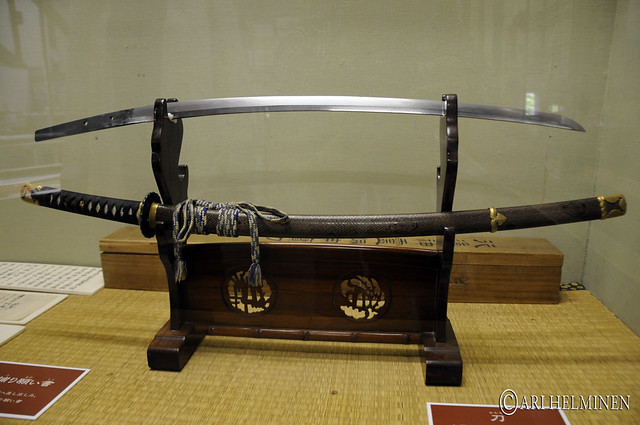 |
| Katana 刀 by Ari Helminen flickr |
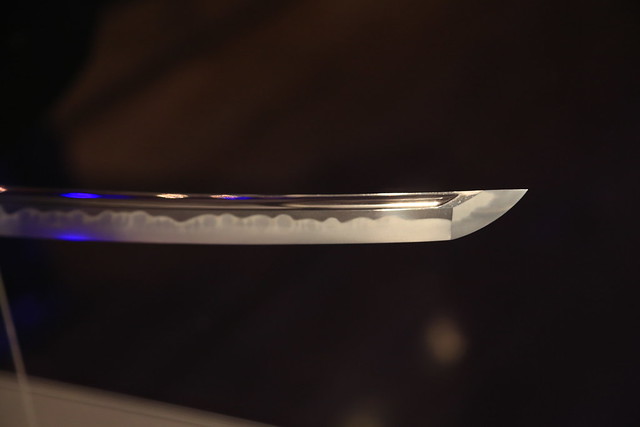 |
| 大和ミュージアム by Norio.NAKAYAMA /flickr |
Swordsmiths combine one or two kinds of Japanese steel together to adjust the carbon content during the forging process, and several kinds of steel are created. Japanese swords were made up of 2-4 kinds of steel having different carbon content: soft steel with carbon content about 0.3%(the core of sword), hard steel with carbon content about 0.8%(the blade edge), hard steel(the spine of sword), medium steel with carbon content about 0.6%(both sides of blade).
They include almost no chemical elements other than iron and carbon, so they can be forge welded without flux. Japanese forged cutting tools are produced by mechanical alloying.
 |
Japanese sword smiths, Akimori Miyagi(宮城昭守) and his son Norizane Miyagi(宮城典真)
in Shiraishi City, Miyagi Prefecture
photo by Miyagi Prefectural Tourism Division
|
The tools heated to over 800 degrees Celsius is quenched not in oil, but in water. Only part of edge can be hardened through heating. Heated normal steel gets cracked by quenching in water. The forged cutlery is an alloy of steels with different carbon concentrations, so it prevents the cutlery from cracking.
 |
| photo by Miyagi Prefectural Tourism Division |
Uchihamono(打刃物, forged iron cutting tools) in Nakaniida(中新田), Kami-machi, Miyagi Prefecure
It is said that a swordsmith started it there in the late 17th century. Nakaniida's forged iron cutlery such as knife, sickle is made with the same method as Japanese swords.
Tatara-based iron making cpmpleted in the mid-18th century is only one of ironmaking methods. The ancient swords produced during the Kamakura Period(1185-1333) and the the Northern and Southern Courts period(1334-1392) are considered the highest-grade swords, but it's unclear how they were made. They were made of soft steel, but they are sharper than swords made in other periods. Their blades are composite of several kinds of steel due to primitive iron making methods. Japanese swords have been meant to be a work of art since tama-hagane(hard steel) came to be used in sword-making in the Edo Period, a warless period.
Osafune(?) made in the 15th century at the Tokyo National Museum
The Society for Preservation of Japanese Art Swords(日本美術刀剣保存協会) runs Nittoho Tatara, and the employees of Hitachi Metals Yasugi Works operate it. Several swordsmiths and researchers have small tatara furnaces, but it seems to be difficult to make perfect steel.
This traditional method has a low yield rate. It is ill-suited to mass production. Tatara-based iron making had gone into a gradual decline since the introduction of western-style iron making method in the late 19th century. Its commercial production ended in 1925.
The Society for Preservation of Japanese Art Swords rebuilt the Nittoho tatara ironworks with support from the Agency for Cultural Affairs to provide Japanese steel to Japanese sword smiths in Okuizumo, Shimane Prefecture in 1977.
Only about 300 swordsmiths licensed by the Agency for Cultural Affairs are allowed to make Japanese swords, and each swordsmith is permitted to make two sword a month.
All traditional swords made in Japan have to be registered with a local prefectural government. Japanese swords with Torokusho(registration certificate) are available.
The owners of five tatara ironworks in Okuizumo(奥出雲) and Hoki(伯耆) established the Unpaku Steel Limited Partnership Company(雲伯鉄鋼合資会社) to manufacture and sell tatara products in a district near Yasugi Harbor, Shimane Prefecture in 1899. This later became Hitachi Metals Yasugi Works.
Hitachi Metals used modern technologies to develop Yasugi Specialty Steel(YSS) with the unique characteristics (i.e., the purity) of Japanese steel.
The company is one of suppliers of steel strips for razor blades. It is said that YSS accounted for 60-70% in the world market of razor blade steel and was supplied to razor makers such as Gillette, Schick, Wilkinson in the mid-2000s. Some people say its current world market share makes about 40-65%, but I'm not really sure about it.
In Japan, most Japanese cuisine cheffs use a knife with YSS blade, and many professional-quality cutting tools have YSS blades.
In 2014, the exhibition will take place at Maison de la culture du Japon à Paris, Paris, France from April 30 to June 21, at Museo ABC, Madrid, Spain from July 5 to September 28.
"Lance of Longinus”appears in Evangelion
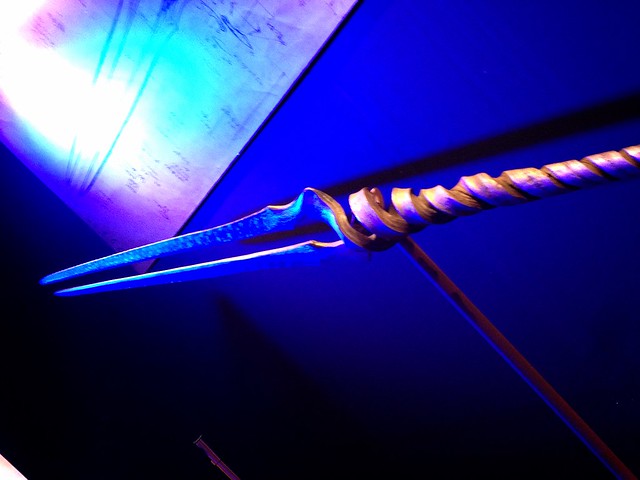 |
| 2013-03-22 by Norio.NAKAYAMA /flickr |
Saturday, January 25, 2014
Izumo Shrine and Ise Shrine
Winter festivals are being held:
http://www.jreast.co.jp/tabidoki/winter/index.html (Japanese version only)
Izumo Grand Shrine(出雲大社) in Shimane Prefecture and Ise Jingu Shrine carried out Sengu(遷宮, transferring deities to new or restored shrine buildings) last year. Izumo Shrine transfers its deity(大国主大神, Okuninushi-no-okami) to its restored building once a every 60 years. At the shrine, the transfer used to be done at irregular intervals. The shrine building was rebuilt after its collapse due to aging. The transfer has been held once a every 60 or 70 years after 1609. The current main sanctuary was built in 1744 and has been designated as a national treasure.
I've been to Izumo Taisha Shrine decades ago. I took the Taisha Line. The shrine was located in a quiet neighborhood surrounded by rice paddies. Though it was regarded as the second highest ranking Shinto shrine in Japan, it had a relaxed and sunny atmosphere. Now the shrine and its approach are bustling with many young women.
haiden(worship hall)
Visitors can't enter the honden(main sanctuary) of Izumo Shrine.
gate of honden
restored honden from an anterior view
old honden from a lateral view
restored honden from a lateral view
restored honden
restored honden from a behind view
The deity was returned to the restored shrine at a ritual called Senzasai(遷座祭) was held on May 10 this year.
On January 3, a banner flag called Kitcho-san(吉兆さん) parade down the street and 42 year-old men with devil masks called Bannai(番内) hold a ceremony to drive away evil spirits at every door. Forty-two is said to be a critical age for a man.
The 10th month in the lunar calendar(corresponding to November in the solar calendar) was named Kanna-zuki(神無月), when all of Shinto deities gather at Izumo Grand Shrine(出雲大社, Izumo Oyashiro or Izumo Taisha) in Shimane Prefecture. Now many harvest festivals are held in October.
It is said that the Shinto deities other than Ebisu gather at Izumo Grand Shrine(出雲大社, Izumo Oyashiro or Izumo Taisha) in Shimane Prefecture in the 10th month in the lunar calendar (corresponding to November in the solar calendar) because they have a meeting to build ties among people. So the month was called "God presence month" in Izumo area, and "God absence month" in other areas.
Shinto priests belonging to the shrine receive the deities at Inasanohama Beach on the 10th day of the 10th month in the lunar calendar(corresponding to November 12 last year). They hold rituals on the 11th, 15th, 17th days of the 10th month in the lunar calendar(corresponding to November 13, 17 and 19 last year). Visitors can't attend these rituals but can see them.
Visitors can attend "Enmusubi-taisai"(matchmaking festival) on the 15th, 17th days of the 10th month in the lunar calendar. Advance reservations are required. General participants write wishes on ema (a votive horse tablet). The priest recites a Shinto prayer. Court dance and music called kagura is dedicated to the shrine. The representatives of 47 prefectures dedicate ema tablets to the shrine. General participants dedicate ema after the ritual.
The shrine is popular with young women because Okuninushi is popularly known as a matchmaking deity. Many people from far away visit the shrine. It's not clear since when the shrine has been said to bring romance. It was famous for the shrine of matchmaking in the mid-Edo Period.
They send the deities off on the 17th day of the 10th month in the lunar calendar(corresponding to November 19 last year).
According to a theory, "zenzai"(rice cakes and boiled sweet adzuki beans) comes from "Jinzai-mochi"(神在餅) offered to the deities during their stay in Izumo.
People eat zoni(雑煮) containing rice cakes and sweetened adzuki beans in some areas of Tottori and Shimane prefectures. Zoni is a soup containing rice cakes, vegetables, some kind of meat. It is served on New Year's Day. However, it's cooked in various ways according to regional custom.
For your information, Izumo soba (the buckwheat noodles of Izumo Province) tastes good.
Incidentally, Ebisu looks after people during the deities' absence. Ebisu(夷、戎、胡、蛭子、恵比須、恵比寿、恵美須) is an ancient Japanese deity and came to be regarded as the deity who brings people success in business and the safety of their families. Many shrines across Japan hold Ebisu-kou(えびす講) on November 19 and 20.
On an unrelated topic, rare phenomena were observed in Izumo area on October 18, 2013. A sundog, a 22° halo, and a circumzenithal arc appeared together.
Izumo Taisha is officially known as Izumo Oyashiro. "Oyashiro(大社)" literally means "big shrine" in Japanese. Oyashiro used to mean Izumo Oyashiro. For your information, "Jingu" means Ise Jingu Shrine.
Records show that its main sanctuary was 96 meters tall in remote antiquity, 48 meters in the 10th century, and they were so tall that they repeatedly fell down. The exsiting main sanctuary is 24 meters tall. People doubted that such tall buildings existed.
reconstructed models of ancient Izumo Shrine
In 2000, three 1.35-meter diameter timbers were unearthed from the grounds of the shrine.
They were bundled together to form one huge post. Another two posts were unearthed in the same year. It is estimated that the timbers were the posts of a sanctuary built in the 13th century.
Ancient writings include stories about the origin of Izumo Taisha Shrine.
According to Kojiki (古事記, Record of Ancient Matters), Amaterasu pressed Okuninushi to cede control over Izumo to her. Okuninushi had two sons. One of them agreed with her without any argument. The other fought against Amaterasu troops, but he lost the fight. Okuninushi requested her to build his grand shrine in return for the handover of his territory.
According to Nihon Shoki (日本書紀, Chronicles of Japan), Amaterasu requested Okuninushi to hand over his territory. He refused it. As an exchange condition, she proposed that Okuninushi would become the deity of the underworld and would have his shrine. He accepted the condition.
According to Izumo-no-kuni Fudoki (出雲国風土記), Okuninushi declared his resolve to turn over the sovereignty of his territories other than Izumo Province to Amaterasu, but he wanted to govern Izumo on his own.
The Yamato kingdom is a coalition government of powerful clans in Yamato(current Nara Prefecture) and Kawachi(a part of Osaka Prefecture). It is thought that the kingdom was established by the late third century. Headmen of the kingdom are regarded as the ancestors of the present-day Imperial Family.
Amaterasu is the female deity of the sun. Emperor Tenmu (天武天皇, 631-686) won the battle after praying to her. It is said that this led the deity to become the ancestor of Imperial Family.
The Naiku of Ise Jingu Shrine is dedicated to Amaterasu. There is a theory that his wife, Empress Jito (持統天皇, 645-703), started Shikinen Sengu of Ise Shrine to justify her succession to the imperial throne by identifying herself with Amaterasu.
Kojiki and Nihon Shoki are old extant chronicles. The preface of Kojiki mentioned that this chronicle was reported to the Emperor in 712. The book is thought to have been written to justify the imperial rule. Nihon Shoki was finished in 720. It is assumed that some inconvenient records for the Yamato kingdom were altered or deleted.
Izumo-no-kuni Fudoki is a fudoki (Description of regional climate, culture, etc.) of the Izumo Province. In 713, Emperor Genmyo ordered to each provision to edit Fudoki. It is said that the book was finished in 733. The fudoki includes many myths about Izumo, and its description differs from the other two chronicles. Though most fudoki books were written by provincial governors dispatched from the central government, a local official wrote this book. He was a member of a powerful local clan in Izumo. It isn't clear why the Yamato kingdom didn't request changes in the contents of Izumo fudoki.
Myths describe could some actual historical events.
Many people think that the Yamato kingdom destroyed the Izumo kingdom. According a theory, the Yamato kingdom built Izumo Shrine for Okuninushi because people feared him who caused disasters and other misfortunes. Some people say that the Izumo kingdom accepted a compromise proposal that Izumo became the center of religion and Yamato became that of politics.
Emperor Sujin (崇神天皇) was the tenth emperor of Japan according to Chronicles of Japan, but most historians consider him as the first emperor who lived from the third century to the beginning of the fourth century. The following careers of Emperor Sujin are mostly based on Chronicles of Japan.
Five years after his accession, many people died of the plague. Amaterasu and Okunitamano-kami(a local deity or Okuninushi) were enshrined in his palace. He thought that Amaterasu caused disasters because she was inherently incompatible with the deity. He moved them out of his palace to end its epidemic. Amaterasu was enshrined in Ise Jingu Shrine during the reign of his son, Emperor Suinin(垂仁天皇).
He enshrined Omononushi-no-okami(Okuninushi) in Omiwa Jinja Shrine(大神神社) in current Nara Prefecture and appointed a descendant of Omononushi as the chief priest of the shrine. The shrine is one of the oldest shrines in Japan. He appointed the chief priest of the shrine enshrining Okunitamano-kami. And then, the plague ended and an abundant harvest ensued.
In 2009, two building remains were discovered at the Makimuku ruins in Sakurai City, Nara Prefecture. An architectural historian said that one had the same style of building as Ise Jingu Shrine and the other had the same style of building as Izumo Taisha Shrine.
He advocates that Makimuku was the capital of the Yamato kingdom which was governed by Emperor Sujin and the two buildings were original forms of Ise and Izumo shrines. However, some people say that Himiko, the queen of the Yamatai-Koku kingdom, governed Makimuku.
Shinto shrines has two types. Most of "Jingu" shrines such as Ise Jingu, Atsuta Jingu have enshrined emperors or the deities deemed to be the ancestors of Imperial Family. There are few Jingu shrines. "Jinja" shrines have enshrined local deities. It is said that Jinja shrines account for 60-70 % of Shinto shrines across the nation.
The Yamato kingdom claimed that many local deities were related to Amaterasu instead of denying the existence of them. Susanoo was the younger brother of Amaterasu, but he was reagrded as not an ancestor of Imperial Family but as a local deity. Those in power often took advantage of deities who cursed people such as Sugawara Michizane, Taira no Masakado.
Now young women visit Izumo Taisha Shrine to make a good match, test takers pray to Sugawara Michizane for passing an entrance exam.
Ise Jingu Shrine has 125 shrines centered on the Naiku(内宮, the inner shrine) dedicated to Amaterasu-omikami(天照大神) and the Geku(外宮, the outer shrine) dedicated to Toyouke-no-omikami(豊受大神). As a matter of fact, some deities including Toyouke-no-omikami enshrined in Ise Shrine are local deities in Ise area.
Izanami chased and caught up with him at the Yomotsu Hirasaka. Izanami said she would kill 1000 people a day. Izanagi replied he would have 1500 babies born each day. Izanagi blocked the road with rocks at the Yomotsu Hirasaka which is the slope that forms the border between the underground and this world.
Legend has it that Izanagi blocked the road with these rocks.
Izanagi is the father of Amaterasu, Tsukuyomi, Susanoo. In Izumo,
Yamatahime-no-mikoto(倭姫命)
Iwami Kagura competition
Izumo Kagura(出雲神楽) is unspectacular and has a low profile compared to Iwami Kagura.
Iya Shrine(揖夜神社) is located near Yomotsu Hirasaka. The shrine is said to be closely connected to the underworld. A mirror is placed in fromt of its main sanctuary.
Love fortune-telling is popular with them. One buys a fortune-telling paper, puts a coin on the paper, and sets it adrift on the pond. The sooner the paper sinks in the pond, the better. The closer the location of the sunken paper is to him/her, he/she will marry the person closer to him/her. A message emerges on the paper when it gets wet.
Kumamo Taisha Shrine
http://www.jreast.co.jp/tabidoki/winter/index.html (Japanese version only)
Izumo Grand Shrine(出雲大社) in Shimane Prefecture and Ise Jingu Shrine carried out Sengu(遷宮, transferring deities to new or restored shrine buildings) last year. Izumo Shrine transfers its deity(大国主大神, Okuninushi-no-okami) to its restored building once a every 60 years. At the shrine, the transfer used to be done at irregular intervals. The shrine building was rebuilt after its collapse due to aging. The transfer has been held once a every 60 or 70 years after 1609. The current main sanctuary was built in 1744 and has been designated as a national treasure.
I've been to Izumo Taisha Shrine decades ago. I took the Taisha Line. The shrine was located in a quiet neighborhood surrounded by rice paddies. Though it was regarded as the second highest ranking Shinto shrine in Japan, it had a relaxed and sunny atmosphere. Now the shrine and its approach are bustling with many young women.
Sightseeing Navigation in Shimane:
 |
| R0010339 by dishhh /flickr |
haiden(worship hall)
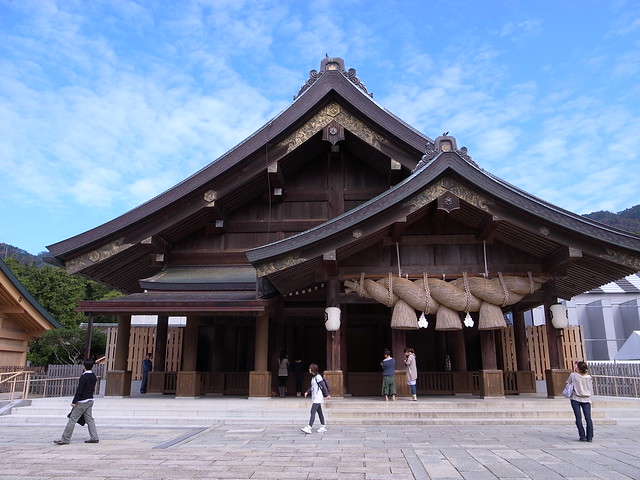 |
| R0010335 by dishhh /flickr |
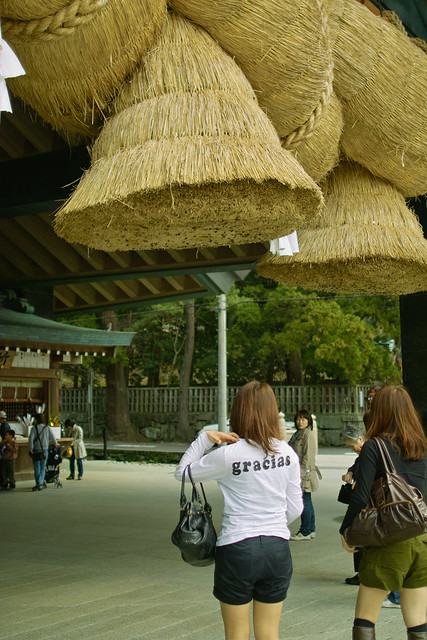 |
| 出雲大社 Izumo Oyashiro shrine by puffyjet /flickr |
Visitors can't enter the honden(main sanctuary) of Izumo Shrine.
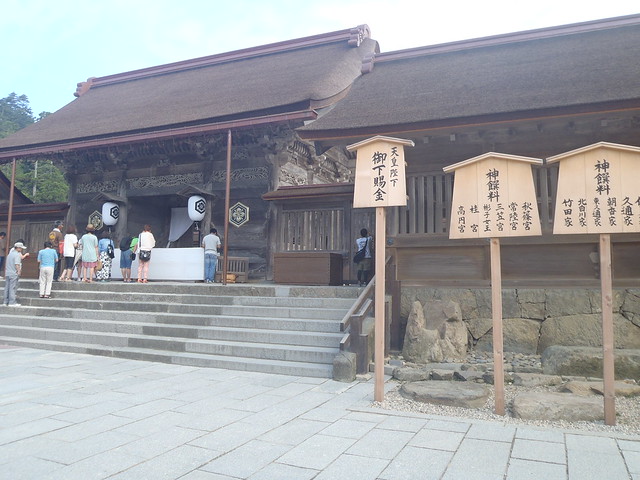 |
| P8130097 by No Boring Stories /flickr |
restored honden from an anterior view
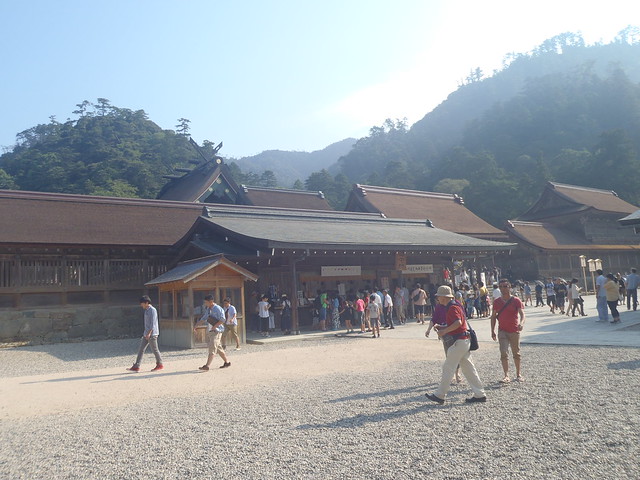 |
| P8130131 by No Boring Stories /flickr |
old honden from a lateral view
 |
| photo by 列島宝物館 |
 |
| P8130109 by No Boring Stories /flickr |
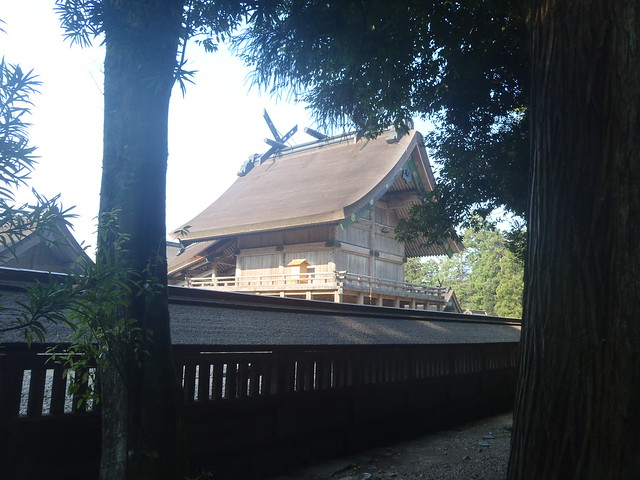 |
| P8130117 by No Boring Stories /flickr |
restored honden from a behind view
 |
| P8130123 by No Boring Stories /flickr |
 |
| photo by Shimane Prefectural Tourism Federaion |
On January 3, a banner flag called Kitcho-san(吉兆さん) parade down the street and 42 year-old men with devil masks called Bannai(番内) hold a ceremony to drive away evil spirits at every door. Forty-two is said to be a critical age for a man.
The 10th month in the lunar calendar(corresponding to November in the solar calendar) was named Kanna-zuki(神無月), when all of Shinto deities gather at Izumo Grand Shrine(出雲大社, Izumo Oyashiro or Izumo Taisha) in Shimane Prefecture. Now many harvest festivals are held in October.
It is said that the Shinto deities other than Ebisu gather at Izumo Grand Shrine(出雲大社, Izumo Oyashiro or Izumo Taisha) in Shimane Prefecture in the 10th month in the lunar calendar (corresponding to November in the solar calendar) because they have a meeting to build ties among people. So the month was called "God presence month" in Izumo area, and "God absence month" in other areas.
 |
Inasanohama Beach(稲佐の浜)
photo by Shimane Prefectural Tourism Federaion
(This pine tree died and was cut down.)
|
Visitors can attend "Enmusubi-taisai"(matchmaking festival) on the 15th, 17th days of the 10th month in the lunar calendar. Advance reservations are required. General participants write wishes on ema (a votive horse tablet). The priest recites a Shinto prayer. Court dance and music called kagura is dedicated to the shrine. The representatives of 47 prefectures dedicate ema tablets to the shrine. General participants dedicate ema after the ritual.
The shrine is popular with young women because Okuninushi is popularly known as a matchmaking deity. Many people from far away visit the shrine. It's not clear since when the shrine has been said to bring romance. It was famous for the shrine of matchmaking in the mid-Edo Period.
They send the deities off on the 17th day of the 10th month in the lunar calendar(corresponding to November 19 last year).
 |
| Izumo zenzai photo by Shimane Prefectural Tourism Federaion |
According to a theory, "zenzai"(rice cakes and boiled sweet adzuki beans) comes from "Jinzai-mochi"(神在餅) offered to the deities during their stay in Izumo.
People eat zoni(雑煮) containing rice cakes and sweetened adzuki beans in some areas of Tottori and Shimane prefectures. Zoni is a soup containing rice cakes, vegetables, some kind of meat. It is served on New Year's Day. However, it's cooked in various ways according to regional custom.
 |
| photo by Shimane Prefectural Tourism Federaion |
For your information, Izumo soba (the buckwheat noodles of Izumo Province) tastes good.
Incidentally, Ebisu looks after people during the deities' absence. Ebisu(夷、戎、胡、蛭子、恵比須、恵比寿、恵美須) is an ancient Japanese deity and came to be regarded as the deity who brings people success in business and the safety of their families. Many shrines across Japan hold Ebisu-kou(えびす講) on November 19 and 20.
On an unrelated topic, rare phenomena were observed in Izumo area on October 18, 2013. A sundog, a 22° halo, and a circumzenithal arc appeared together.
Izumo Taisha is officially known as Izumo Oyashiro. "Oyashiro(大社)" literally means "big shrine" in Japanese. Oyashiro used to mean Izumo Oyashiro. For your information, "Jingu" means Ise Jingu Shrine.
Records show that its main sanctuary was 96 meters tall in remote antiquity, 48 meters in the 10th century, and they were so tall that they repeatedly fell down. The exsiting main sanctuary is 24 meters tall. People doubted that such tall buildings existed.
reconstructed models of ancient Izumo Shrine
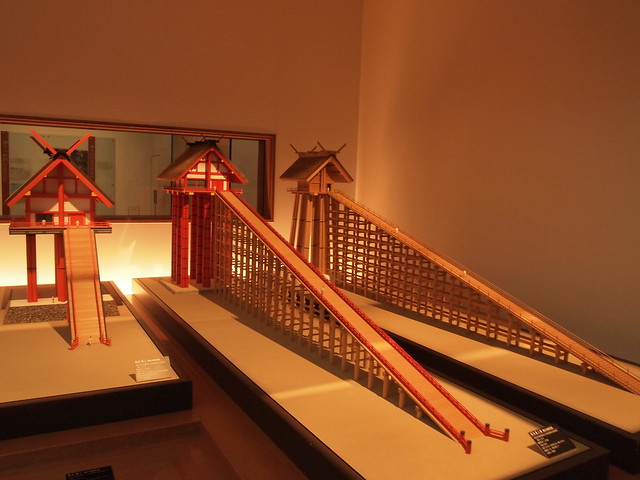 |
| P7104619 by yuen yan /flickr |
In 2000, three 1.35-meter diameter timbers were unearthed from the grounds of the shrine.
They were bundled together to form one huge post. Another two posts were unearthed in the same year. It is estimated that the timbers were the posts of a sanctuary built in the 13th century.
Ancient writings include stories about the origin of Izumo Taisha Shrine.
According to Kojiki (古事記, Record of Ancient Matters), Amaterasu pressed Okuninushi to cede control over Izumo to her. Okuninushi had two sons. One of them agreed with her without any argument. The other fought against Amaterasu troops, but he lost the fight. Okuninushi requested her to build his grand shrine in return for the handover of his territory.
According to Nihon Shoki (日本書紀, Chronicles of Japan), Amaterasu requested Okuninushi to hand over his territory. He refused it. As an exchange condition, she proposed that Okuninushi would become the deity of the underworld and would have his shrine. He accepted the condition.
According to Izumo-no-kuni Fudoki (出雲国風土記), Okuninushi declared his resolve to turn over the sovereignty of his territories other than Izumo Province to Amaterasu, but he wanted to govern Izumo on his own.
The Yamato kingdom is a coalition government of powerful clans in Yamato(current Nara Prefecture) and Kawachi(a part of Osaka Prefecture). It is thought that the kingdom was established by the late third century. Headmen of the kingdom are regarded as the ancestors of the present-day Imperial Family.
Amaterasu is the female deity of the sun. Emperor Tenmu (天武天皇, 631-686) won the battle after praying to her. It is said that this led the deity to become the ancestor of Imperial Family.
The Naiku of Ise Jingu Shrine is dedicated to Amaterasu. There is a theory that his wife, Empress Jito (持統天皇, 645-703), started Shikinen Sengu of Ise Shrine to justify her succession to the imperial throne by identifying herself with Amaterasu.
Kojiki and Nihon Shoki are old extant chronicles. The preface of Kojiki mentioned that this chronicle was reported to the Emperor in 712. The book is thought to have been written to justify the imperial rule. Nihon Shoki was finished in 720. It is assumed that some inconvenient records for the Yamato kingdom were altered or deleted.
Izumo-no-kuni Fudoki is a fudoki (Description of regional climate, culture, etc.) of the Izumo Province. In 713, Emperor Genmyo ordered to each provision to edit Fudoki. It is said that the book was finished in 733. The fudoki includes many myths about Izumo, and its description differs from the other two chronicles. Though most fudoki books were written by provincial governors dispatched from the central government, a local official wrote this book. He was a member of a powerful local clan in Izumo. It isn't clear why the Yamato kingdom didn't request changes in the contents of Izumo fudoki.
Myths describe could some actual historical events.
Many people think that the Yamato kingdom destroyed the Izumo kingdom. According a theory, the Yamato kingdom built Izumo Shrine for Okuninushi because people feared him who caused disasters and other misfortunes. Some people say that the Izumo kingdom accepted a compromise proposal that Izumo became the center of religion and Yamato became that of politics.
Emperor Sujin (崇神天皇) was the tenth emperor of Japan according to Chronicles of Japan, but most historians consider him as the first emperor who lived from the third century to the beginning of the fourth century. The following careers of Emperor Sujin are mostly based on Chronicles of Japan.
Five years after his accession, many people died of the plague. Amaterasu and Okunitamano-kami(a local deity or Okuninushi) were enshrined in his palace. He thought that Amaterasu caused disasters because she was inherently incompatible with the deity. He moved them out of his palace to end its epidemic. Amaterasu was enshrined in Ise Jingu Shrine during the reign of his son, Emperor Suinin(垂仁天皇).
He enshrined Omononushi-no-okami(Okuninushi) in Omiwa Jinja Shrine(大神神社) in current Nara Prefecture and appointed a descendant of Omononushi as the chief priest of the shrine. The shrine is one of the oldest shrines in Japan. He appointed the chief priest of the shrine enshrining Okunitamano-kami. And then, the plague ended and an abundant harvest ensued.
In 2009, two building remains were discovered at the Makimuku ruins in Sakurai City, Nara Prefecture. An architectural historian said that one had the same style of building as Ise Jingu Shrine and the other had the same style of building as Izumo Taisha Shrine.
He advocates that Makimuku was the capital of the Yamato kingdom which was governed by Emperor Sujin and the two buildings were original forms of Ise and Izumo shrines. However, some people say that Himiko, the queen of the Yamatai-Koku kingdom, governed Makimuku.
Shinto shrines has two types. Most of "Jingu" shrines such as Ise Jingu, Atsuta Jingu have enshrined emperors or the deities deemed to be the ancestors of Imperial Family. There are few Jingu shrines. "Jinja" shrines have enshrined local deities. It is said that Jinja shrines account for 60-70 % of Shinto shrines across the nation.
The Yamato kingdom claimed that many local deities were related to Amaterasu instead of denying the existence of them. Susanoo was the younger brother of Amaterasu, but he was reagrded as not an ancestor of Imperial Family but as a local deity. Those in power often took advantage of deities who cursed people such as Sugawara Michizane, Taira no Masakado.
Now young women visit Izumo Taisha Shrine to make a good match, test takers pray to Sugawara Michizane for passing an entrance exam.
Ise Jingu Shrine has 125 shrines centered on the Naiku(内宮, the inner shrine) dedicated to Amaterasu-omikami(天照大神) and the Geku(外宮, the outer shrine) dedicated to Toyouke-no-omikami(豊受大神). As a matter of fact, some deities including Toyouke-no-omikami enshrined in Ise Shrine are local deities in Ise area.
A myth of Izanagi and Izanami in Izumo is remarkably similar to that of Orpheus and Eurydice.
 |
| Yomotsu Hirasaka
photo by Shimane Prefectural Tourism Federaion
|
Yomotsu Hirasaka(黄泉比良坂) is said to be at the entrance to the underworld.
Izanami (The Female Who Invites) made Yomotsu-shikome chase Izanagi (The Male Who Invites) in desire to catch him because he had run away from her. Izanagi run away after seeing his wife Izanami who was dead and cold, breaking his promise.
 |
| Yomotsu Hirasaka photo by Shimane Prefectural Tourism Federaion |
Izanami chased and caught up with him at the Yomotsu Hirasaka. Izanami said she would kill 1000 people a day. Izanagi replied he would have 1500 babies born each day. Izanagi blocked the road with rocks at the Yomotsu Hirasaka which is the slope that forms the border between the underground and this world.
 |
| Yomotsu Hirasaka photo by Shimane Prefectural Tourism Federaion |
Legend has it that Izanagi blocked the road with these rocks.
Izanagi is the father of Amaterasu, Tsukuyomi, Susanoo. In Izumo,
Susanoo met Kushinada-hime who was nearly sacrificed to Yamata no Orochi (eight-headed giant snake). After wiping out the snake, he married Kushinada.
 |
| Sada Shinno photo by Shimane Prefectural Tourism Federaion |
Susanoo-no-mikoto(素盞鳴尊) in Sada Shinno(佐陀神能)
Sada Shinno(佐陀神能) is a kagura (Shinto music and dancing) with a history of over 400 years and is dedicated to the Sada Shrine(佐太神社) in Matsue City, Shimane Prefecture. The shrine appears in Izumo-no-kuni Fudoki(733). The performance has been registered as an Intangible Cultural Heritage by UNESCO.
 |
| Sada Shinno photo by Shimane Prefectural Tourism Federaion |
 |
| Sada Shinno photo by Shimane Prefectural Tourism Federaion |
 |
| Sada Shinno photo by Shimane Prefectural Tourism Federaion |
Yamatahime-no-mikoto(倭姫命)
Kirime-no-mikoto(切女命)
Sada Shrine
(佐太神社)
Iwami Kagura(石見神楽) consists of more than 30 programs. It is famous for its dynamic dances. "Orochi" based on Yamata no Orochi is a very popular program. The snakes coil up, flash their eyes, breathe out fire and smoke. The masks and snakes are made of washi paper.
 |
| orochi in Iwami Kagura photo by Shimane Prefectural Tourism Federaion |
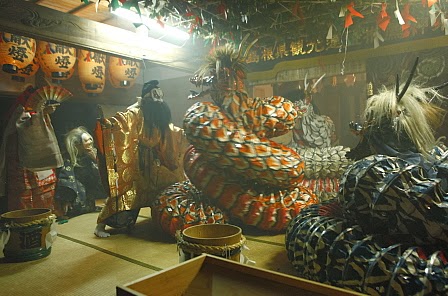 |
| orochi in Iwami Kagura photo by Shimane Prefectural Tourism Federaion |
 |
| orochi in Iwami Kagura photo by Shimane Prefectural Tourism Federaion |
 |
| orochi in Iwami Kagura photo by Shimane Prefectural Tourism Federaion |
 |
| photo by Shimane Prefectural Tourism FederaionOrochi at Iwami |
Iwami Kagura competition
Izumo Kagura(出雲神楽) is unspectacular and has a low profile compared to Iwami Kagura.
However, Some say that Izumo Kagura keeps the flavor of the time when common people started to play kagura that had been dedicated to deities.
Okuninushi fell in love with Susanoo's daughter. Susanoo took Okuninushi through a series of trials. Okuninushi married Susanoo's daughter, and built his magnificent palace on the advice of Susanoo.
A hare tricked some wani(shark or crocodile) into forming a line and tried to go over their backs. One of wani skinned the hare in angry. Okuninushi's elder brothers intentionally offered treatment advice to worsen the condition of the hare. Okuninushi offered an appropriate treatment, and the hare made a recovery.
In Izumo Taisha Shrine, there are the statues of Okuninushi and the hare.
 |
| 出雲大社 Izumo Oyashiro shrine by puffyjet /flickr |
There are a lot of other shrines related to Izumo myths.
Susa Shrine(須佐神社) appears in Izumo-no-kuni Fudoki. Susanoo is enshrined in the shrine.
It it said that the current main sanctuary was built in 1554.
The main sanctuary of Kamosu Shrine(神魂神社) has been designated as a national treasure.
It is said that the current main sanctuary was built in 1583.
 |
| main sanctuary of Kamosu Shrine photo by Shimane Prefectural Tourism Federaion |
 |
| Iya Shrine photo by Shimane Prefectural Tourism Federaion |
Iya Shrine(揖夜神社) is located near Yomotsu Hirasaka. The shrine is said to be closely connected to the underworld. A mirror is placed in fromt of its main sanctuary.
 |
| Iya Shrine photo by Shimane Prefectural Tourism Federaion A mirror is placed in fromt of its main sanctuary |
 |
| Iya Shrine |
 |
| Hinomisaki Shrine photo by Shimane Prefectural Tourism Federaion |
Hinomisaki Shrine(日御碕神社) has two shrines. Its lower shrine called Hishizumi-no-miya(日沈の宮) was built by order of Emperor Shomu to defend Japan during the night while Ise Shrine defended Japan during the day. The shrine was moved to its present location by order of Emperor Murakami in 947.
 |
| Yaegaki Shrine photo by Shimane Prefectural Tourism Federaion |
Yaegaki Shrine(八重垣神社) is popular as the shrine of matchmaking because the shrine is located where Susanoo and Inada-hime(Kushinada) set up a new home. Many young women visit here.
 |
| Yaegaki Shrine photo by Shimane Prefectural Tourism Federaion |
Love fortune-telling is popular with them. One buys a fortune-telling paper, puts a coin on the paper, and sets it adrift on the pond. The sooner the paper sinks in the pond, the better. The closer the location of the sunken paper is to him/her, he/she will marry the person closer to him/her. A message emerges on the paper when it gets wet.
 |
| photo by Shimane Prefectural Tourism Federaion |
Kumamo Taisha Shrine
(熊野大社)
 |
| photo by Shimane Prefectural Tourism Federaion |
Nagahama Shrine
(長浜神社)
Subscribe to:
Posts (Atom)
